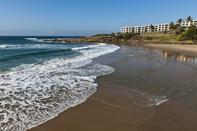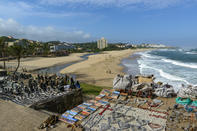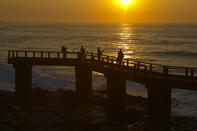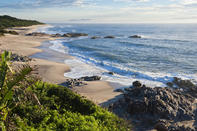Survey of the Beaches

Next morning, despite the murky firmament, I decided on a systematic survey of the beaches. My Opel Astra Classic sang the road south, floating like the road-lover it is. It was drizzling as I glided across the Mzimkulu and into Port Shepstone, past the 19th-century cast-iron lighthouse standing tall in its black-and-white checks. The river was mud-brown and spilling its colour into the ocean. Main street was grim: fast-food joints, shopping centres, oversize garages. Too industrialized for me, I thought, so southward....
Shelly Beach was burdened with a vastly ugly, behemoth shopping complex, but the boats were loaded with a good catch down at the ski-boat club. The point at St Michael’s on Sea, often a perfect right, wasn’t working and the surfers looked miserable without their fix. I pressed on.
The sun had to produce the goods eventually and I happened to be in just the right spot: Uvongo. It’s the classic South Coast beach, framed by weathered shale and offering all the tropical stereotypes: cascading waterfall, tranquil lagoon, cliffs rioting with vegetation and warm water. Developers had done their best to ruin it, but the beach itself was simply wonderful. It had everything the holidaymaker could want: a paddling pool for kids, lifesavers with rippling muscles, safe bathing, colourful pedallos and canoes for hire, and blondes held together by the tiniest triangles of cloth.
Margate Beach

Sitting there watching the parade of fun seekers, I realised that this was really what the Deep South was all about. None of Hermanus’ or Plettenberg Bay’s pretensions; no icicles forming on the Clifton nose; no stoical shelter from the stormy Port Elizabeth blast, no North Coast sundowner insect repellent and nervous listening for the mozzie drone. Just good, plain, family fun in the sun. And why not?
It’s holidaymakers’ heaven: a supertube, paddling pools, beauty competitions and concerts on the beach. The promenade was lined with sellers of fruit, baskets and trinkets. I met Ndaya Tumba from the Congo who spoke only French and sold masks from Swaziland and colourful plastic gorillas. “How’s business?” I asked. “Pas mal, monsieur, not bad” he said.
I walked on down to the palm-lined promenade, marvelling at the indiscretions. Who in the town council allowed a Wimpy, complete with its full wardrobe of garish signage, right on the beach, I wondered! Behind stood serial apartment blocks, like the scene of an aesthetic crime. I found a perch above the beach beside a bunch of grommets eyeing the shore-break - barrel-hollow and Limpopo-brown from the rains. Lifesavers boomed warnings about the undertow to bathers who launched themselves into the waves undeterred. Like Uvongo, Margate Beach had every amenity the visitor could want - if amenities are what you’re after.
South Explorer Route

From the stories I’d heard, he wasn’t exaggerating. Each winter there’s a huge migration of pilchards close inshore. These shoals are followed by a frenzy of game fish, dolphins, sharks, birds... and of course ecstatic anglers. Sometimes millions of fish are beached by the incoming tide and locals scoop them up by the bucketful.
Next day it was raining again, so I decided to put the ball in Tourism Margate’s court. “This is exactly the sort of situation our South Explorer route is designed for – days when you can’t enjoy the beach,” said Vicky Erasmus. The touring meander takes in 55 fun things to do along the coast. “Why don’t you try a section of our craft route?” suggested Vicky.
The biggest concentration of arts-and-craft icons on my Southern Explorer map was along the Old Pont Road near Port Edward. At Africarve Kevin Simpson explained how he’d given up his supertube business, moved to the coast and turned to the world of wood, producing intricately carved doors.
Further down Old Pont Road I came to Emithini - Place in the Trees, a craft centre focusing on hand-painted fabrics, clothing and homeware. Gillian le Roux explained that she had six local women helping her create works. Cool drum-and-base music sifted through trees hung with bedspreads in a kaleidoscope of blues and greens. The effect was quite ethereal.
Warmth of the South Coast

Next day I was exploring the coast south of Margate. Ramsgate had a pretty beach with a lagoon and Southbroom was being pounded by a surf without rhyme or rhythm. A child flicked cartwheels along the creamy high-water line.
It was near here that the 319-ton barque Ivy was wrecked in 1878. She was carrying a full cargo of cases loaded with gin, wine and ale bound for Durban. The ship was left high and dry at low tide and locals from all corners of the district sped to the scene of an almighty party which still lives on in local lore.
Port Edward had a beautiful unspoilt beach and a quiet estuary adorned with a marvellous Cape Dutch-style manor house. I reflected on my expectations and misconceptions. Yes, in parts – particularly the north of this region – the coast is over-developed, town planning is often virtually non-existent and subtropical vegetation has in many places given way to man-made intrusions of every shape and size.
But then there’s the warmth of a South Coast greeting, that friendly, laid-back, nothing’s-too-much-hassle-as-long-as-you’re-not-in-a-hurry vibe exuded from toddler to toppie. The place has the aura of being a bit off the pace that’s quite endearing. They know they’re not glamorous Cape Town, but don’t care for pretensions. The rates are affordable, the feel is homely. Then there’s the subtropical vegetation in every shade of green that overwhelms you. And the humidity, debilitating at first, induces a kind a soporific euphoria. Okay, so it wasn’t too bad.
By Justin Fox